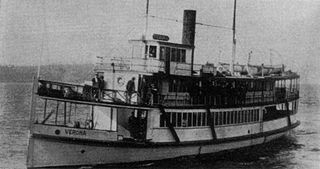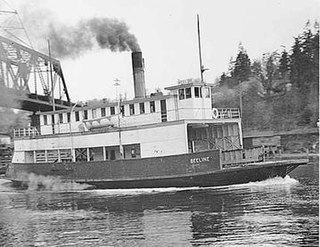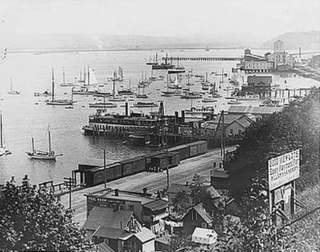
Lake Washington steamboats and ferries operated from about 1875 to 1951, transporting passengers, vehicles and freight across Lake Washington, a large lake to the east of Seattle, Washington. Before modern highways and bridges were built, the only means of crossing the lake, other than the traditional canoe or rowboat, was by steamboat, and, later, by ferry. While there was no easily navigable connection to Puget Sound, the Lake Washington Ship Canal now connects Lake Washington to Lake Union, and from there Puget Sound is reached by way of the Hiram M. Chittenden Locks.

The King and Winge Shipbuilding Company was an important maritime concern in the early 1900s on Puget Sound. The shipyard was located at West Seattle. The owners were Thomas J. King (1843–1925) and Albert M Winge. King was born in Boston and learned to build ships under the famous Donald McKay. He came to Puget Sound in about 1880, and worked in the shipyards of Hall Bros. and T.W. Lake before starting his own shipyard with Winge. King’s partner, Albert L. Winge was a native of Norway.

The steamboat Aquilo operated on Lake Washington and Puget Sound in the first part of the 20th century.

The steamboat Defiance operated in the early 1900s as part of the Puget Sound Mosquito Fleet. In later years this vessel was called Kingston.

The steamboat Rosalie operated from 1893 to 1918 as part of the Puget Sound Mosquito Fleet, also operating out of Victoria, B.C. In 1898, Rosalie went north with many other Puget Sound steamboats to join the Klondike Gold Rush.

Tacoma was a steamship that served from 1913 to 1938 on Puget Sound. Built of steel, Tacoma was known for being one of the fastest and best-designed vessels to operate on Puget Sound. Tacoma was particularly noted for high-speed service from 1913 to 1930 on the route between Tacoma and Seattle.

The steamship Verona was a small steamboat of the Puget Sound Mosquito Fleet.

Hyak was a wooden-hulled steamship that operated on Puget Sound from 1909 to 1941. This vessel should not be confused with the sternwheeler Hyak which ran on the extreme upper reach of the Columbia River at about the same time. The name means "swift" or "fast" in the Chinook Jargon.
The La Conner Trading and Transportation Company was founded in the early 1900s by Joshua Green and others, to engage in the shipping business on Puget Sound.
Elk was a steam tug that operated on Puget Sound, and earlier, from 1880 to 1896, on Lake Washington under the name of Katherine.

Quickstep was a steamboat that operated from 1877 to 1897 in coastal, inland waters and rivers of the Pacific Northwest. This vessel should not be confused with a number of other vessels with the same name, some of which operated in the same area about the same time.

Florence K was a steamboat that was operated on Puget Sound from 1903. This vessel was later renamed Gloria and was rebuilt as a steam ferry and renamed Beeline.

Inland Flyer was a passenger steamboat that ran on Puget Sound from 1898 to 1916. From 1910 to 1916 this vessel was known as the Mohawk. The vessel is notable as the first steamer on Puget Sound to use oil fuel. Inland Flyer was one of the most famous vessels of the time on Puget Sound.

General Miles was a steamship constructed in 1882 which served in various coastal areas of the states of Oregon and Washington, as well as British Columbia and the territory of Alaska. It was apparently named after US General Nelson A. Miles.

The West Seattle Land and Improvement Company was a real estate development concern that conducted business in West Seattle starting in 1888. Through a subsidiary, the Oregon and Washington Ferry and Navigation Company, the company also owned and operated two ferries that operated between the company's developments in West Seattle and Seattle itself, which was then a separate city which was difficult to reach over land routes of the time.

King County was a steam ferry built in 1900 which served on Lake Washington until 1908.

C.C. Calkins was a small steamboat built in 1890 which served on Lake Washington.

Kirkland was a sidewheel steamboat that ran on Lake Washington from 1888 to 1898.

Atlanta was a steamboat built in 1908 at Houghton, Washington which served on Lake Washington and Puget Sound until 1938, when it was converted into a diesel-powered houseboat.

The steamboat Acme operated on Lake Washington and also on the Sammamish Slough to Bothell, Washington from 1899 to 1910, when it was destroyed by fire.


















